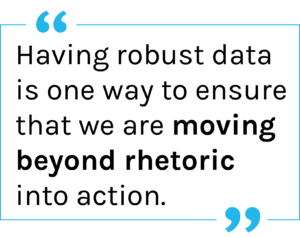
Accelerate DEI programs by understanding the efforts of your peer institutions
Diversity, equity, and inclusion (DEI) work in HigherEd is part of the national conversation, and furthering DEI initiatives on campus is everyone’s responsibility. From student and faculty recruitment efforts to building an inclusive culture, DEI work is expansive. However, data can help you measure the success of your efforts, and understanding where your peers stand can help your institution in many ways.
How data helps your DEI efforts
Internal data is vital to understanding where you stand with your DEI efforts. One university wrote in Inside Higher Ed about how they determined the data they would need to inform decisions about DEI work across campus. They determined they needed data beyond “the number of students, faculty and staff of color, gender or rank,” and needed to figure out how to capture information that examined the “actual experiences of colleagues and students of color in our college.” The article notes, “If a college or university touts that we are ‘doing great in regards to diversity,’ it needs to have data to support that assertion…. Having robust data is one way to ensure that we are moving beyond rhetoric into action.”
Beyond your data
While internal data can certainly help you understand your institution’s growth and the success of your DEI efforts, it’s also important to look at other higher education institutions for comparison. Peer data can help you understand your own efforts in a few ways.
comparison. Peer data can help you understand your own efforts in a few ways.
- Roadmap for the future – Seeking out information about what other colleges and universities are doing to advance DEI can help you keep up to date on best practices, and inspire next steps for your own institution. Use success (and failure) stories from other colleges and universities as part of your own roadmap.
- Compare and contrast – Your institution likely has a good idea of how far your DEI efforts have advanced, but have you made as much progress as you thought? Looking at your own progress compared to your peer schools can help your team understand if you’re really pushing forward, or if you’re still taking comparative baby steps.
- Tell your story – Taking a look at peer data can also help you tell your DEI story. Maybe you’ve taken huge steps in advancing inclusive workspaces or increasing equity for student populations—steps that other colleges and universities in your area have not yet taken. Tell that success story, and let your peers use your best practices as a roadmap to the future.
- Data-informed strategies – Peer data can also be invaluable when bringing DEI plans and strategies to leadership. If you’re falling behind your peers, or you see a strategy that worked at another institution, you can bring a data-backed plan forward and hold institutional leadership accountable by demonstrating the pressing need for action.
 What’s next?
What’s next?
Ready to take the next step with DEI data? First, find out what you’re measuring or tracking internally (and make sure your office has a robust analytics tool). Check out some of these DEI resources from EDUCAUSE and CUPA-HR. When you’re ready to examine information from other colleges and universities, check out PeopleAdmin’s Talent Intelligence, which leverages actionable peer data so you can make informed decisions and know where to focus your efforts.